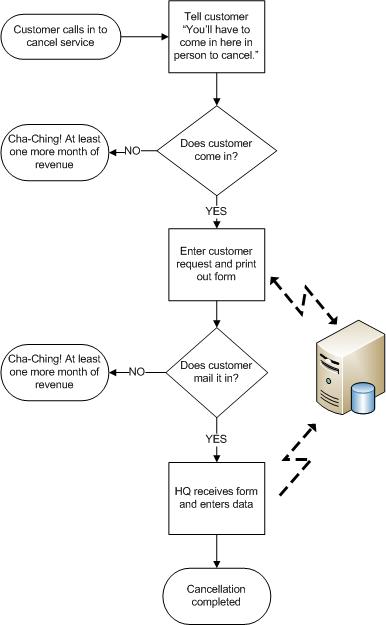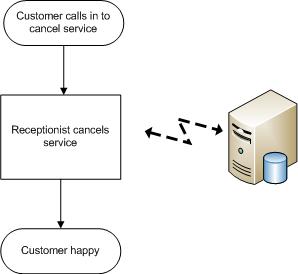> Continuous Improvement Articles
Customer Service: Retention to an Extreme
I had an interesting experience with my health club this week. It had to do with what I am presuming is a customer retention policy.
I was cancelling one of the services they offer, but keeping the membership. First off, they told me I could not do this over the phone-I had to come in and take care of it in person. Strike one against customer service.
When I got into the club, the process was something that could have easily been done back when I called in. I gave the receptionist my name, and she entered my request.
But then came a confusing step.
She printed out a form that I had to send in. No signature. No extra information. I just had to put a stamp on it and drop it into a mailbox. Seemed rather pointless to me, especially when she already had me pulled up on the database. Strike two against customer service.
Here’s what I presume that process flowchart looks like…

- Customer Service: Retention ‘Before’ Flowchart
Here’s a bit of free consulting for my gym on what an improved process looks like…

- Customer Service: Retention ‘After’ Flowchart
There might be more to this than what I see here-after all, I am an outsider looking at the process without complete information. But I am also a customer. And this looks like a way to improve their retention at the expense of my customer service.
Sometimes customer service is a problem because of inefficiency-going through one line for one step, and then waiting in another line for a second process (think DMV or X-rays at a HMO).
In this case, though, it is hard to draw any other conclusion about this process than that it is intended to delay cancellations and squeeze a few more dollars out of customers-dollars that the customer doesn’t get any value for.
Overall, I like the facility, and the employees are friendly. With only two strikes, I probably won’t quit the gym, but I would be hard pressed to recommend it to any of my friends or neighbors-all because of this process.
It is no wonder that health clubs have bad reputations in this regard. They are not doing much to help themselves shake off that stigma.
I’d love to hear from anyone who knows something about this process that I don’t. I like having faith in people and in business. Please help me find an alternative explanation for this process.

2 Comments
Dragan Bosnjak · July 16, 2009 at 4:48 am
Hi Jeff,
Beautiful example of lean thinking, thx. I have put your link on my blog (it’s in italian language but you can read it with google translator if you want…) in my blogroll. It talks about lean thinking and entries like yours are always welcome and very well accepted by my audience. So if you would like to write a guest post or something like that, you’re welcome!
Cheers
Dragan Bosnjak
Jeff Hajek · July 16, 2009 at 11:21 pm
Thanks for the comment. Always nice to get feedback and know I’m hitting the mark.